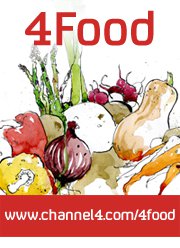
Back in the olden days, the only fresh veggies available to eat in the long dark Scottish winter were potatoes and when the potato crop failed there was scurvy. Scurvy (overt vitamin C deficiency) is thankfully [virtually] unheard of in the modern age, but the urban legend of the student who ate nothing but porridge got me wondering. Are those of us trying to eat locally through the winter eating a wide enough range of fruit and vegetables to get all of the nutrients that we need? Don’t worry, I’m not suggesting that we are all about to get scurvy, but I don’t think there is any harm in putting a bit of attention into making sure that you fit a couple of good sources of vitamin C into every day, especially if you have slipped comfortably into a routine of roasted root veggies for dinner.
There’s still no evidence that lots of vitamin C will stop you getting a cold, unless you are living life on the edge in extremes of cold or physical stress (soldiers, marathon runners – it might help you guys out), but you do need a top-up of it every day for a whole host of important bodily functions. Vitamin C makes collagen for you, the connective network of tissues in your skin and bones, as well as carnitine, without which you feel would be feeling very tired and weak. It is also one of those antioxidant nutrients, working hard in combination with other antioxidants to stop the kind of damage to individual cells and arteries that can lead to cancer and heart disease over time. Last but not least, vitamin C gets to work every time you eat a vegetarian iron-rich food making sure that you absorb as much of the iron as possible.

There are a whole host of good and relatively sustainable sources of vitamin C for the winter months:
Juicy fruit
There are lots of fine fruity sources of vitamin C (raspberries, kiwi fruit, citrus, pomegranate) and sadly none of them are growing anywhere near here in the middle of winter. In Britain importing fruit in Winter is a centuries old practice and meeting your five-a-day is difficult without it come February/March/April (the hungry gap) when even the British apples have run out. Delicate fresh strawberries and raspberries are lovely and full of vitamin C but to my mind they are going to taste all the better for the wait next Summer. A workable compromise position is to buy fruit that is sturdy enough to ship and which comes from the same continent (so this week Spanish clementines are in).
Finding out how your fruit has arrived in the shops can be tricky – hassle your regular supplier for more information if their labelling isn’t very helpful. Certain suppliers and certification schemes will do this for you – the Soil Association is looking at excluding air freighted produce from its certification programme and many organic box schemes only provide shipped imported produce, no airfreight.
A glass of orange juice most days has been my trusted winter back-up plan. Organic orange juice, imported in concentrate form before being rehydrated, and storable for months in the cupboard in its longlife recyclable carton tastes more of oranges than many of the refrigerated, supposedly fresh not from concentrate brands. But is it more environmentally friendly? It sounds like it should be but reading the article Carton vs. Canister on Slate makes me less sure – the jury is out on this one. Your body won’t mind which you choose – most orange juice brands are fortified with a little extra ascorbic acid (vitamin C) to make up for any that might be lost in transit and to help preserve the juice until you drink it.
Love leafy and green
The true winter vitamin C superstar is the Brussels sprout. Fabulous if you like them, not such exciting news if you have to be forced to eat a token two on Christmas day. For sprout phobes, savoy cabbage, kale and red cabbage are also good sources and another great source, purple sprouting broccoli, is one of the first new vegetables of the winter to spring transition.
For all of these veg the quickest cooking methods that involve the least contact with water will provide the biggest serving of vitamin C – think stir-frying, steaming and microwaving. Red cabbage needs a long cooking time to soften so how about mixing and matching, serving half cooked and and the other half raw in a coleslaw along the lines of the one I wrote about a few weeks ago.
Go frozen
Like most of these pertinent food ethics questions, there is no easy way to find out from an intelligent and reliably source if buying frozen vegetables in the Winter is better for the environment than buying imported. This is a whole new area of research that nobody knew we were going to need and we’re just not that good at it yet. Tackling the problem from a simple stance, yes a freezer takes energy to run (way less than an aeroplane), but buying frozen will generally give you a more nutritious product and will let you support producers from your own country and possibly even local area.
Frozen fruits and vegetables are very nutritious; picked at their seasonal best and frozen immediately before volatile nutrients like Vitamin C have the time to think about deteriorating. Frozen spinach and peas are both good sources of vitamin C. Whole leaf spinach is immensely versatile and can be stirred into pretty much anything saucy: tomato-based pasta sauces, curries, chillies and casseroles. Peas go with so many meals – an easy, low washing-up option is to throw a cupful of frozen peas in with your rice for the last five minutes of cooking.
For the sweet toothed, mixed bags of frozen summer berries are a little too slushy to eat by hand but work really well in smoothies, in a crumble alongside apple or just with a dollop of yogurt (as in these pictures). Bakers secretly love frozen berries for cakes and muffins because they don’t sink to the bottom quite so readily as fresh.

These values are for the raw products and a proportion will be lost if the food is cooked (see higher up the page for suggestions for the best cooking methods).
Brussels Sprouts 115mg
Curly Kale 110mg
Broccoli 87mg
Cabbage 49mg
Cauliflower 43mg
Orange Juice 39mg
Frozen Berries 29mg
Frozen peas 24mg
And the values for a few other winter vegetables provided for contrast:
Leeks 17mg
Parnsip 17mg
Carrots 6mg
To put those cooking losses into perspective, the amount of vitamin C that nutritionists think is enough for most healthy adults is between 40mg and 60mg every day (recommendations vary internationally), with a little extra suggested for pregnant and breast feeding women, as well as smokers.

 Come join me on Twitter
Come join me on Twitter Sophie Roberts is a registered dietitian based in Oxford, UK. She loves combining her nutrition know-how with a sustainable approach to buying and preparing food and shares her tips and recipes here at Mostly Eating.
Sophie Roberts is a registered dietitian based in Oxford, UK. She loves combining her nutrition know-how with a sustainable approach to buying and preparing food and shares her tips and recipes here at Mostly Eating. 
{ 8 comments }
Another very informative post. Thank you!
It may not be proven that vitamin C helps prevents colds but whenever I feel a sniffle coming on I eat vast amounts of oranges. Have to say, I don’t remember the last time I had a bad cold.
This makes sense Wendy. I’m ever the scientist with these things and although vitamin C doesn’t seem to stop people getting colds, it does stop colds being quite so bad and lasting for so long once you’ve been unfortunate enough to catch one
how about herbs? don’t parsley and dandelion have tons of vitC, more even than an orange? or the more exotic fruit, like guava and pawpaw? mind you, those will have lost all their vit content being picked way too early and shipped around the world to reach us… your yoghurt seems the way to go, but i’ll stick with the fruit, even though the sprouts might have more vits, i can’t for the life of me imagine drinking them in a smoothie ;-)
It’s not too far away from wintertime here in New Zealand, so I’ll have to keep in mind all those vitamin C-rich foods. Luckily we eat plenty of broccoli, cabbage, cauliflower, peas and potatoes in our household already, so I don’t think we’ll be coming down with scurvy any time soon. :)
Hi Johanna – yuck, sprout smoothie! I keep hearing about people eating them raw in salads but I haven’t picked up the courage to try them. You’re right about the more exotic fruits – my aim has been to avoid importing from afar as much as possible hence the emphasis on frozen goods and very bog standard vegetables. Parsley has around 190 mg of vitamin C per 100g (loads!) but the big difference between herbs and fruit and veggies is that people eat them in much lower quantities – they tend to be a minor ingredient or garnish (unless you eat parsley salads or make tabbouleh in the very traditional way). My garden parsley has died but theoretically it should be possible to keep parsley growing through the British Winter.
Ric – potatoes is a good one which I missed out. They come fairly low down the list, somewhere between leeks and carrots, but the advantage with potatoes is that a lot of people eat them regularly. I hate to say it but one of the highest potato sources of vitamin C is potato chips/crisps because they are cooked so quickly!
Glad to hear that there’s no scurvy in NZ :-)
Luckily living in Florida, we have lots of oranges and fresh fruit to keep us going year round. But I must say, doing a little research on frozen veggies, I turn towards them when something “green” is out of season here. My favorite frozen veggie is Peas! They are great as a snack, yes just pop them in your mouth while frozen and go in as a filler in many stews and pastas. And they are great just on their own as a side dish! No, I do not work for a pea farm…just love um’!
Great informative post Sophie!
Great informative post. :) I had no idea that peas were a significant source of vitamin C. I think I “stirfry” my vegetables too long so I should try to be more organized when I’m cooking and not end up doing that.
It’s quite funny how I discovered your very pretty blog just now! I actually left a comment on someone else’s blog, and I noticed there was a comment already left by a “Sophie” but I initially thought it was my own! As I was reading it, I was thinking to myself “Wait a minute, I didn’t say that” because I’m the only Sophie with a food blog…or at least I used to think so! Nice meeting you! It’s nice to know that I share a name with someone who has great blogging skills, your pictures are truly amazing and I really like how crisp your entire blog looks!
Sophie :)